This is a complete guide to DADGAD tuning for beginners and is part of our larger series on alternate tunings. In the article below you’ll learn:
- What DADGAD tuning is and why it’s used
- How to tune your guitar from standard tuning
- Some simple, movable chords you can use
- DADGAD Chords – Common major and minor open chord shapes
- Useful scales
- Some great songs and artists that play in DADGAD
And a whole lot more.
So, if you have wanted to get started with DADGAD, but didn’t know where to begin, stay tuned! But, if short on time, I’ve summarized a few of the main points below.
DADGAD tuning is a tuning that requires you to tune to D-A-D-G-A-D. From standard tuning, you simply detune the 6th, 2nd, and 1st strings down a whole step. Once in tune, the open strings form a Dsus4 chord. Due to the middle three strings being the same as standard tuning, it’s a tuning that offers some familiarity.
Looking for a more detailed explanation? Continue reading.
What is DADGAD Tuning?

DADGAD tuning (pronounced DAD GAD) aka Celtic Tuning, Dsus4 or modal tuning is an alternate tuning that is mostly associated with Celtic music but is also utilized in many other genres, including blues and folk as it lends itself particularly well to fingerstyle guitar.
Much like drop D and double drop D tuning DADGAD is less of a departure from standard tuning. In practical terms, this means it’s less challenging going from standard tuning and transposing scales and chord shapes compared to other alternate tunings. It’s also a reasonably intuitive tuning to play around in if you have already experimented in drop D as the 4 bass strings are tuned identically. Also, the interval between the 5th and 6th strings is the same as in standard tuning e.g. a fifth.
What is modal tuning?
Model tunings are alternate tunings that are not tuned to a major or minor chord. Unlike open tunings which are mostly tuned to a major triad e.g. open G, which is tuned to G major and requires the notes of the G major triad: (G-B-D). When playing all open strings in DADGAD you will hear a Dsus4 chord, which is a suspended chord that does not contain a major or minor third which distinguishes if a chord is major or minor.
Where did DADGAD tuning Originate from?
It was popularized by Davey Graham, a folk guitarist from the UK in 1964 who upon hearing an oud player in Morocco began experimenting with different tunings, eventually coming up with DADGAD tuning.
The Oud (an 11-stringed instrument, similar in appearance to a lute, only with a shorter neck) is considered the precursor to the lute, and most likely played an important role in the evolution of the guitar. It is still played today and is popular in the Middle East, Spain, and Greece.
Why play in DADGAD Tuning?
So why tune to DADGAD? What are the advantages on offer?

Firstly, it’s one of the simplest alternate tunings to tune to as the name includes the open string notes.
Aside from being just an easy tuning to remember, one of the real features of DADGAD is its airy, open feel courtesy of the tuning facilitating simple, movable chord shapes that incorporate lingering open notes (drones) against fretted notes.
This is especially the case in the keys of D and A due to the three open D strings and two open A strings. In short, you’re going to be playing a lot of open strings in DAGDAD.
And, because the three open D strings and two open A’s are each an octave apart, chords that include notes an octave higher or lower (by simply replacing or adding the adjacent A or D string at the same fret position), immediately make chords sound majestic and exotic.
If writing the tuning down with octaves in mind, we have the following: D2-A2-D3-G3-A3-D4.
This means the low D (6th string) is taken from the second octave, while the high D (1st string) is taken from the 4th octave.
This is another reason why, In simple terms, DADGAD offers a lot of bang for buck, and makes your playing sound sophisticated, even playing very simple chord shapes.
A sense of familiarity
Along with drop D, DADGAD is one of the more common alternate tunings, especially on the acoustic guitar. It’s a great alternate tuning to get started with as you will already feel a sense of familiarity, courtesy of half the guitar remaining in standard tuning, the middle three strings A, D, and G.
Because the three unchanged strings are adjacent to one another the use of many familiar patterns or single-note runs you might normally play in standard tuning can be incorporated into your playing, along with playing triads across the three middle strings while taking advantage of the unique flavour this tuning provides.
Is DADGAD anything like open D?
While DADGAD is not to be mistaken for open D, it is a very similar tuning. The only exception is the third string, which in open D is tuned to F# to form the major D triad. A small but significant difference, making open D an open tuning and DADGAD a modal tuning.
DADGAD
| 6 | 5 | 4 | 3 | 2 | 1 |
| D | A | D | G | A | D |
Open D
| 6 | 5 | 4 | 3 | 2 | 1 |
| D | A | D | F♯ | A | D |
How to tune to DADGAD
 Tuning from standard tuning
Tuning from standard tuning
When it comes to tuning to DADGAD it’s simple for a couple of reasons.
First, and as already touched on, the tuning itself is in the name. This is a lot easier to remember, making it a far more accessible tuning than many open tunings.
To tune to DADGAD do the following:
- Tune your low E to D using your 4th string as a reference (down a whole step)
- Leave your A, D and G strings as they are
- Tune the B string down a whole step to A (reference the 5th string)
- Tune the high E string a whole step down to D (reference the middle D string).
A quick way to think about tuning to DADGAD is to simply tune the 1st, 2nd and 6th strings down a whole step e.g. two frets.
Tuning from drop D or double drop D
Secondly, if you are familiar with drop D you will only need to adjust the 1st and 2nd strings. If playing in double drop D there is only one more string that needs to be changed, the 2nd string from B to A.
Playing in key
Like all alternate tunings, DADGAD offers specific advantages and disadvantages depending on the key you are playing, making some chord voicings simpler and others very difficult.
It’s a tuning that obviously lends itself to playing in the key of D and Dm and less for keys such as Eb Ab and Bb. Which, if you are familiar with the circle of fifths makes sense as these are further away from the key of D on the circle, meaning their respective scales contain less common notes.
What’s the circle of fifths?
The diagram below shows the circle of fifths, each hour represents a note e.g. 12 hours, 12 notes in an octave. The circle of fifths is a really helpful tool to get your head around for a number of reasons and deserves a complete article on its own. But, for the sake of understanding which keys are best suited to DADGAD tuning, as we know the tuning is well suited to the key of D (due to the three open D strings) we can use the circle of fifths to work out other keys that will also work well in this tuning. In practical terms this means, that the closer to the key of D in the diagram below the more open strings can be included in chords. Playing in an unrelated key means fewer open strings available. As you can see, Eb Ab, and Bb are direct opposite on the outside circle and relate more closely to the notes closer to them on the circle.

Chord Voicings
Another thing to keep in mind in DADGAD is the three D strings and two A strings and the possibilities this provides to play less common chord voicings.
In practical terms when it comes to chords this means any note played on one of the D strings can be doubled or substituted using any of the remaining D strings, likewise with the A strings.
This means unique chord voicings can be played including doubling any notes used to assemble the chord, playing a note in a higher or lower octave, and playing inversions that may not otherwise be as readily available.
What’s an Inversion?
When it comes to chords, inversions refer to rearranging the notes that make up the chord. For example, take an A Major chord, which is a triad (e.g. made up of three notes from the respective major scale, the 1st (A), the third (C♯), and the fifth (E), A is the root and the lowest note of the three. If however we take the C♯ and lower it an octave it then becomes the lowest note and this arrangement of notes becomes the first inversion of C Major. Likewise, if we lower the 5th (E) an octave it is then the lowest note, making this arrangement the second inversion of C Major.
DADGAD Chords
Simple (one-finger) DADGAD chords
One of the features of playing chords in DADGAD tuning is it allows for a number of simple chord shapes e.g. played using just one finger that in turn incorporate open string drones e.g. holding the fretted note with an underlying open string ringing out beneath.
D5 chord
Aside from playing all the open strings that form a Dsus4 chord, the simplest chord to begin with in DADGAG is the D5 chord, which requires just one finger on the 2nd fret of the G string, or it can also be played with the 1 – 3 strings muted:
 |  |
If you move the finger on the second fret of the G string to the 5th string a Gadd9/D chord is formed. And, if you move down to the 4th string and mute the 6th string you have a lush sounding A7sus4.
Knowing these three very basic shapes gives you an I, IV, and V chord progression.
 |  |  |
Power Chords
As already touched on when discussing the D5 chord, aka D power chord above the 4th, 5th and 6th strings are identical to drop D tuning (and double drop D for that matter) by muting the three highest strings a complete arsenal of power chords is available at your fingertips by simply fretting the 4th, 5th and 6th strings on the same fret number, which give us a 5th or power chord with the root note doubled, courtesy of the low D(6th string) and next highest octave D (4th string).

And, much like drop D (and double drop D), we can double the 5th scale degree by incorporating the 3rd string and fretting the note two frets lower on the neck:
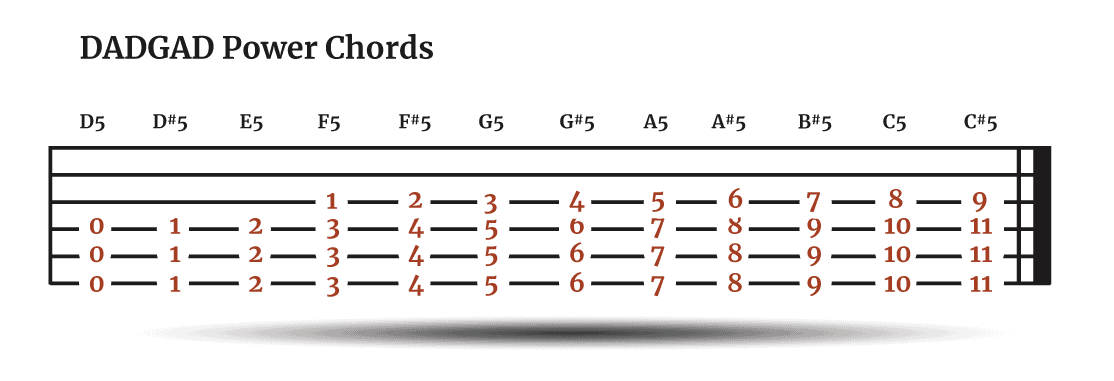
Major and Minor Chords
The diagrams below show suggested voicings for all open-position major and minor chords in DADGAD.
As you can see DADGAD tuning makes many open-position chord voicings more difficult to play e.g. the B and C chord examples below. In most cases due to how the tuning is arranged with respect to open strings, you will find yourself mostly playing variations in open position e.g. 7th and 9th chords or sus or add chords. The B Major in particular is a chord you probably won’t find yourself leaning on too heavily in DADGAD tuning.
There are of course any number of alternative voicings available, however in the interests of keeping things simple the chord voicings suggested below do not require muting strings between fretted strings.
Also, keep in mind, In general, the most important chords to learn are in the key of D, A and G
Open Position Major Chords
 | 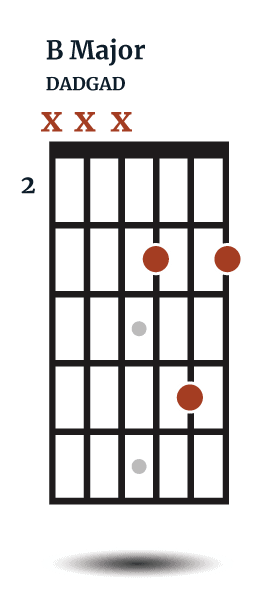 | 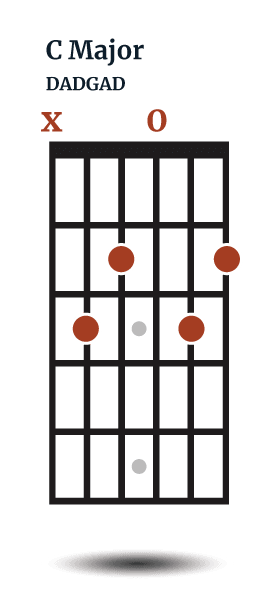 |  |
 |  |  |
Open Position Minor Chords
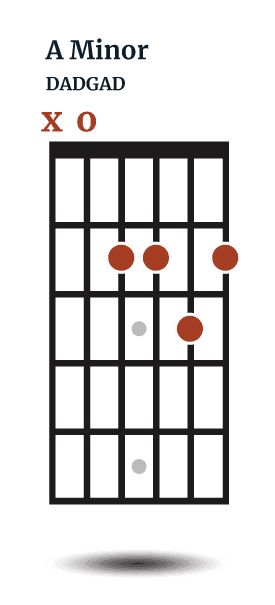 | 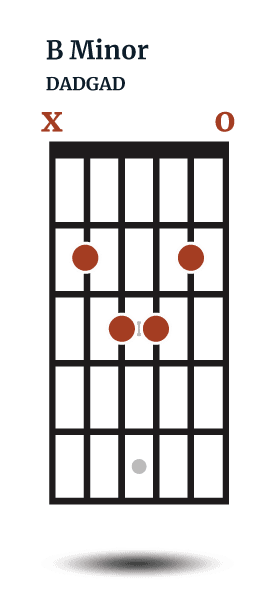 |  |  |
 |  | 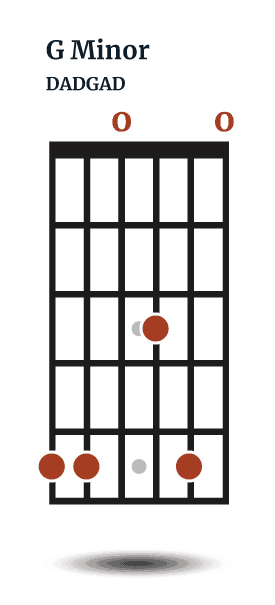 |
Movable Chords
When it comes to alternate tunings it’s smart to learn a major shape and a minor shape that are movable, as this allows you to play any chord in the tuning without needing to memorize open chord positions.
Try the following chord shapes, shown in both E and E minor below. Moving the E major shape up to the fourth fret results in a G major chord, an A major chord on the 6th fret and so on.
The minor shape is also movable, but being a minor the third (scale degree) is flattened by a half step, meaning the open string is required to play E minor but is then fretted on the 3rd fret if playing a G minor for example.
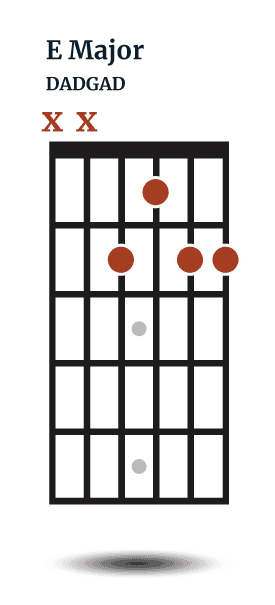 |  |
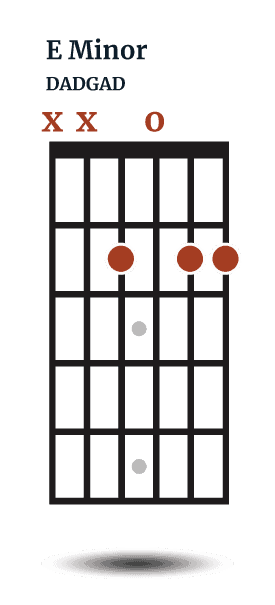 |  |
Other useful chords
Along with the chords above, there are also chord shapes that are particularly well suited to DADGAD tuning.
 |  |  |  |
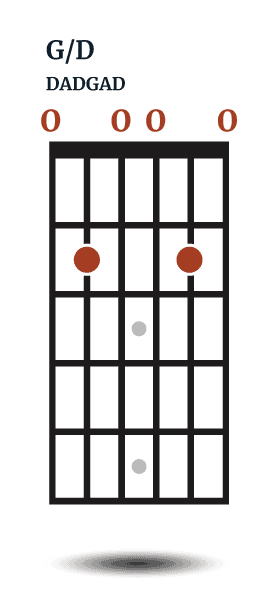 |  |  |  |
 |  |
Scales
If you consider the intervals in DADGAD tuning e.g.
- D – root (6th string)
- A – fifth (fifth string)
- D – root (fourth string)
- G – fourth (third string)
- A – fifth (second string)
- D – root (sixth string)
Because there is no third, it is neither major nor minor giving it a suspended, ambiguous feel. This also means we can incorporate major and minor scales.
One simple trick is to learn the major and minor scales using the three middle (and unchanged from standard tuning) strings. E.g.


While the two scales above are handy as they are unchanged from standard tuning, playing the major scale as per the example below demonstrates what makes DADGAD tuning special with regard to blending open strings with faster decaying fretted notes, giving a harp-like quality to the scale.


Fingerstyle Guitar
The examples above are also why fingerstyle works well in DADGAD. The abundance of open notes in the form of the three D strings, which allow the doubling of any notes played on either of the D strings, really thickens up the sound and adds notes that extend past the octave to common chord shapes.
The two A strings allow similar advantages, providing an octave between the 5th string A and 2nd string A (formerly B).
This is demonstrated in this intermediate tutorial below from Darrel Braun.
Players and Songs in DADGAD
Lastly, if you are interested in hearing more DADGAD tuning the songs below are great examples of DADGAD and include songs that you may be surprised to learn are in this tuning.
| Artist | Song |
| Led Zeppelin | Kashmir |
| Black Mountain Side | |
| John Renbourn | Lindsay |
| Colin Hay | I Just Don’t Think I’ll Ever Get Over You |
| Norwegian Wood (cover) | |
| Del Amitri | Tell Her This |
| Ed Sheeran | Photograph |
| Neil Young | Goin Back |
| Soggy Bottom Boys | Man of Constant Sorrow |
| Phil Keaggy | County Down |
| Luka Bloom | Holy Ground |
Summary
DADGAD is a great alternate tuning and one I recommend experimenting with, especially if you write original music. Like all alternate tunings, it will take some time to become acquainted with and become comfortable with the modal nature of the tuning. But, it also offers enough for the uninitiated to begin making exotic-sounding ideas come to life quite quickly. So if you are ready to open new creative pathways for your acoustic guitar playing why not tune your guitar to D-A-D-G-A-D and start playing around with some of the one-finger chords outlined at the beginning of this article before moving on to some of the more advanced chords and scales available.


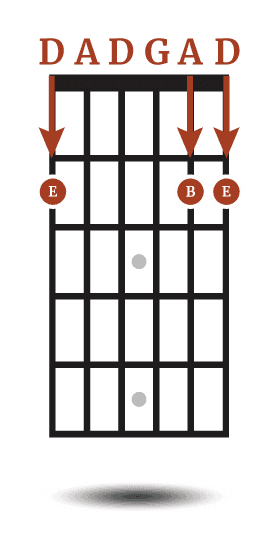 Tuning from standard tuning
Tuning from standard tuning
![Open F Tuning [Complete Guide]](https://theacousticguitarist.com/wp-content/uploads/2022/08/open-f-tuning-banner-image-300x131.gif)

Thank you!